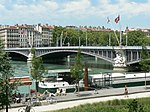Lyon-Jean Macé station
7th arrondissement of LyonLyon–Geneva railwayRailway stations in France opened in 2009Railway stations in Lyon

Lyon-Jean Macé station (French: Gare de Lyon-Jean Macé) is a railway station in the 7th arrondissement of Lyon. It is situated on the Paris–Marseille railway and the Lyon–Geneva railway. The station is a part of the Lyon urban area rapid transit network. It was aimed to decongest the major stations Part-Dieu and Perrache while allowing access to the public transport of Lyon (TCL). The station began operation on 13 December 2009.
Excerpt from the Wikipedia article Lyon-Jean Macé station (License: CC BY-SA 3.0, Authors, Images).Lyon-Jean Macé station
Avenue Jean Jaurès, Lyon Jean-Macé
Geographical coordinates (GPS) Address Nearby Places Show on map
Geographical coordinates (GPS)
| Latitude | Longitude |
|---|---|
| N 45.7451 ° | E 4.8416 ° |
Address
Avenue Jean Jaurès
69007 Lyon, Jean-Macé
Auvergne-Rhône-Alpes, France
Open on Google Maps







